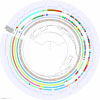Community carriage of ESBL-producing Escherichia coli and Klebsiella pneumoniae: a cross-sectional study of risk factors and comparative genomics of carriage and clinical isolates
- PMID: 37306968
- PMCID: PMC10470604
- DOI: 10.1128/msphere.00025-23
Community carriage of ESBL-producing Escherichia coli and Klebsiella pneumoniae: a cross-sectional study of risk factors and comparative genomics of carriage and clinical isolates
Abstract
The global prevalence of infections caused by extended-spectrum β-lactamase-producing Enterobacterales (ESBL-E) is increasing, and for Escherichia coli, observations indicate that this is partly driven by community-onset cases. The ESBL-E population structure in the community is scarcely described, and data on risk factors for carriage are conflicting. Here, we report the prevalence and population structure of fecal ESBL-producing E. coli and Klebsiella pneumoniae (ESBL-Ec/Kp) in a general adult population, examine risk factors, and compare carriage isolates with contemporary clinical isolates. Fecal samples obtained from 4,999 participants (54% women) ≥40 years in the seventh survey of the population-based Tromsø Study, Norway (2015, 2016), were screened for ESBL-Ec/Kp. In addition, we included 118 ESBL-Ec clinical isolates from the Norwegian surveillance program in 2014. All isolates were whole-genome sequenced. Risk factors associated with carriage were analyzed using multivariable logistic regression. ESBL-Ec gastrointestinal carriage prevalence was 3.3% [95% confidence interval (CI) 2.8%-3.9%, no sex difference] and 0.08% (0.02%-0.20%) for ESBL-Kp. For ESBL-Ec, travel to Asia was the only independent risk factor (adjusted odds ratio 3.46, 95% CI 2.18-5.49). E. coli ST131 was most prevalent in both collections. However, the ST131 proportion was significantly lower in carriage (24%) versus clinical isolates (58%, P < 0.001). Carriage isolates were genetically more diverse with a higher proportion of phylogroup A (26%) than clinical isolates (5%, P < 0.001), indicating that ESBL gene acquisition occurs in a variety of E. coli lineages colonizing the gut. STs commonly related to extraintestinal infections were more frequent in clinical isolates also carrying a higher prevalence of antimicrobial resistance, which could indicate clone-associated pathogenicity.IMPORTANCEESBL-Ec and ESBL-Kp are major pathogens in the global burden of antimicrobial resistance. However, there is a gap in knowledge concerning the bacterial population structure of human ESBL-Ec/Kp carriage isolates in the community. We have examined ESBL-Ec/Kp isolates from a population-based study and compared these to contemporary clinical isolates. The large genetic diversity of carriage isolates indicates frequent ESBL gene acquisition, while those causing invasive infections are more clone dependent and associated with a higher prevalence of antibiotic resistance. The knowledge of factors associated with ESBL carriage helps to identify patients at risk to combat the spread of resistant bacteria within the healthcare system. Particularly, previous travel to Asia stands out as a major risk factor for carriage and should be considered in selecting empirical antibiotic treatment in critically ill patients.
Keywords: Escherichia coli; Klebsiella pneumoniae; antimicrobial resistance; bacterial genomics; carriage; extended-spectrum β-lactamase; general population; risk factors.
Conflict of interest statement
The authors declare no conflict of interest.
Figures





References
-
- NORM/NORM-VET 2021 . 2022. Usage of antimicrobial agents and occurrence of antimicrobial resistance in Norway. Tromsø/Oslo/Ås; ISSN: 1502-2307 (print)/1890- 9965 (electronic).
-
- Scheuerman O, Schechner V, Carmeli Y, Gutiérrez-Gutiérrez B, Calbo E, Almirante B, Viale P-L, Oliver A, Ruiz-Garbajosa P, Gasch O, Gozalo M, Pitout J, Akova M, Peña C, Molina J, Hernández-Torres A, Venditti M, Prim N, Origüen J, Bou G, Tacconelli E, Tumbarello M, Hamprecht A, Karaiskos I, de la Calle C, Pérez F, Schwaber MJ, Bermejo J, Lowman W, Hsueh P-R, Navarro-San Francisco C, Bonomo RA, Paterson DL, Pascual A, Rodríguez-Baño J, REIPI/ESGBIS/INCREMENT investigators . 2018. Comparison of predictors and mortality between bloodstream infections caused by ESBL-producing Escherichia coli and ESBL-producing Klebsiella pneumoniae. Infect Control Hosp Epidemiol 39:660–667. doi:10.1017/ice.2018.63 - DOI - PubMed
-
- Tacconelli E, Carrara E, Savoldi A, Harbarth S, Mendelson M, Monnet DL, Pulcini C, Kahlmeter G, Kluytmans J, Carmeli Y, Ouellette M, Outterson K, Patel J, Cavaleri M, Cox EM, Houchens CR, Grayson ML, Hansen P, Singh N, Theuretzbacher U, Magrini N, Aboderin AO, Al-Abri SS, Awang Jalil N, Benzonana N, Bhattacharya S, Brink AJ, Burkert FR, Cars O, Cornaglia G, Dyar OJ, Friedrich AW, Gales AC, Gandra S, Giske CG, Goff DA, Goossens H, Gottlieb T, Guzman Blanco M, Hryniewicz W, Kattula D, Jinks T, Kanj SS, Kerr L, Kieny M-P, Kim YS, Kozlov RS, Labarca J, Laxminarayan R, Leder K, Leibovici L, Levy-Hara G, Littman J, Malhotra-Kumar S, Manchanda V, Moja L, Ndoye B, Pan A, Paterson DL, Paul M, Qiu H, Ramon-Pardo P, Rodríguez-Baño J, Sanguinetti M, Sengupta S, Sharland M, Si-Mehand M, Silver LL, Song W, Steinbakk M, Thomsen J, Thwaites GE, van der Meer JW, Van Kinh N, Vega S, Villegas MV, Wechsler-Fördös A, Wertheim HFL, Wesangula E, Woodford N, Yilmaz FO, Zorzet A. 2018. Discovery, research, and development of new antibiotics: the WHO priority list of antibiotic-resistant bacteria and tuberculosis. Lancet Infect Dis 18:318–327. doi:10.1016/S1473-3099(17)30753-3 - DOI - PubMed
Publication types
MeSH terms
Substances
LinkOut - more resources
Full Text Sources
Miscellaneous

